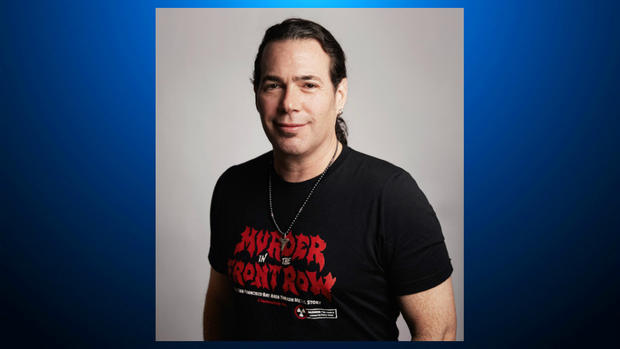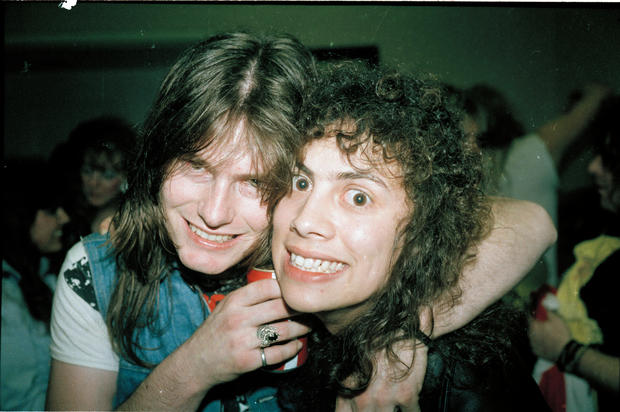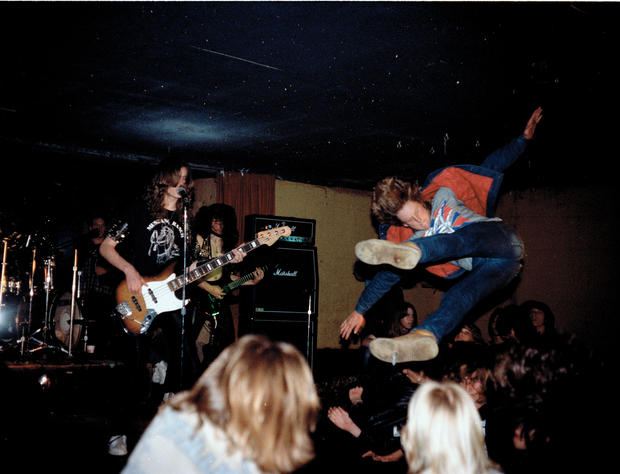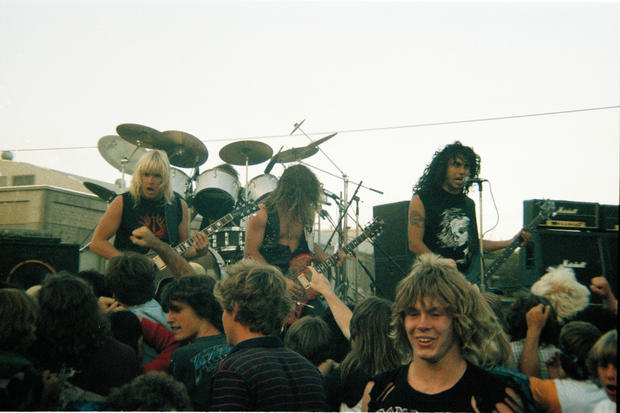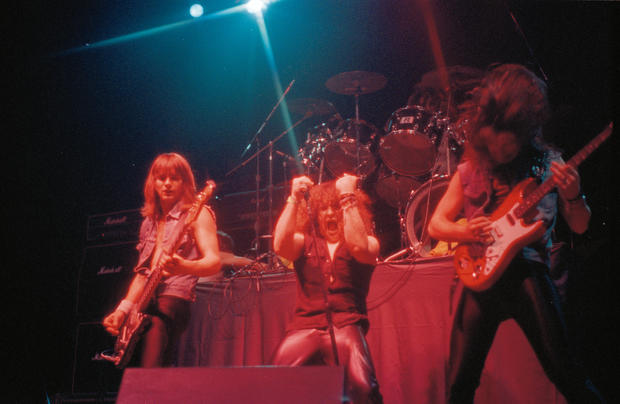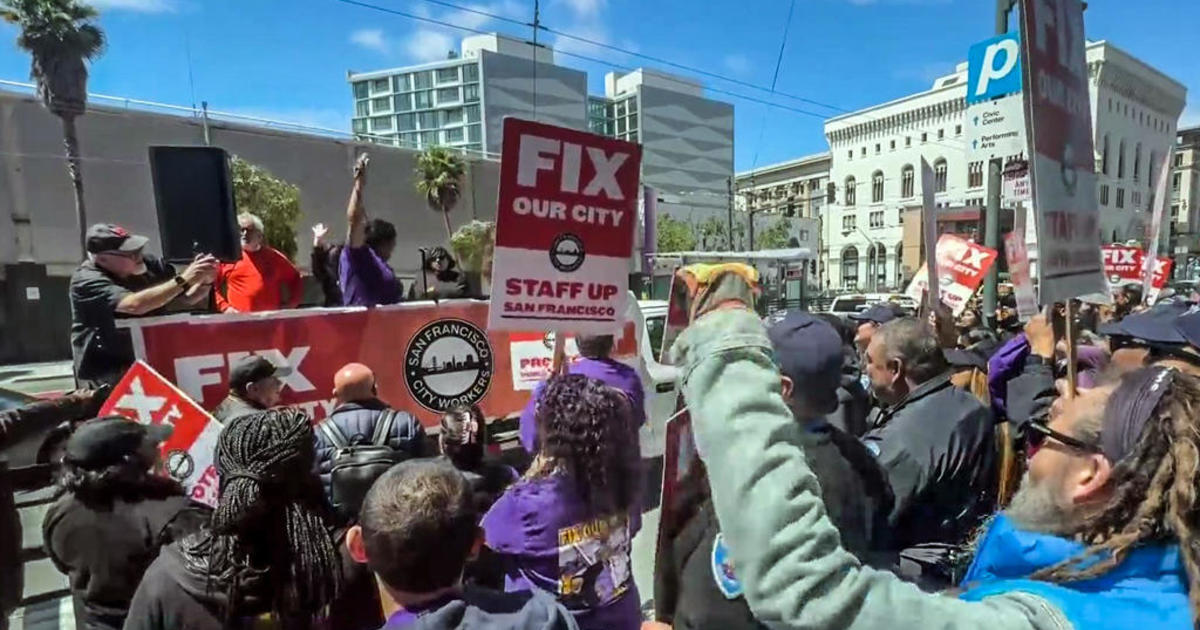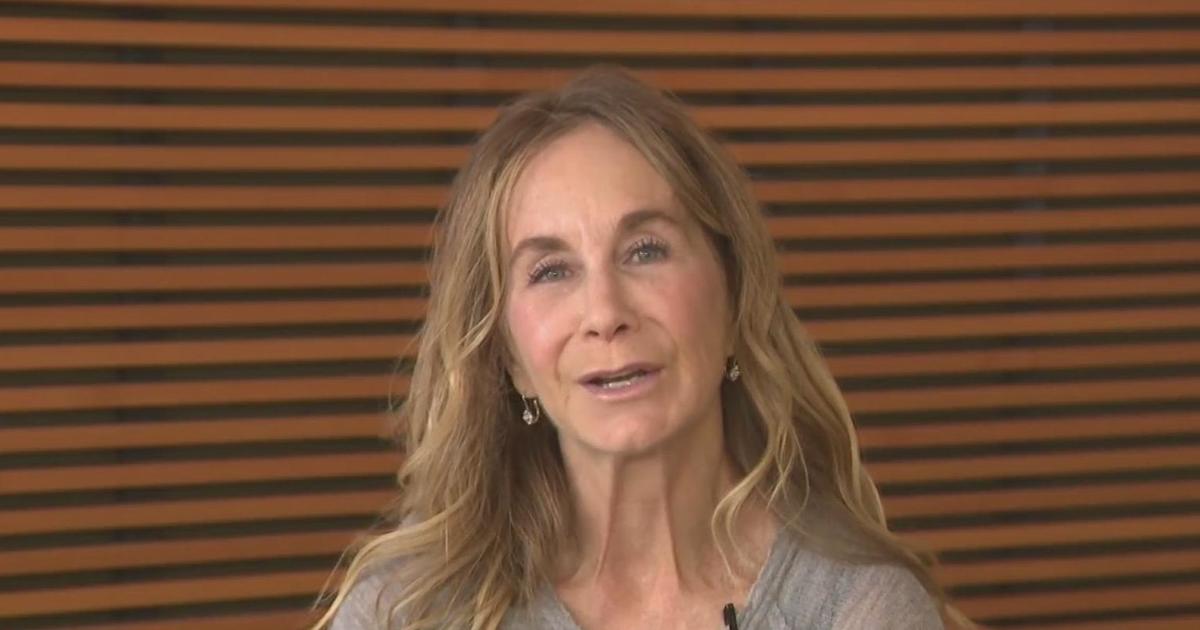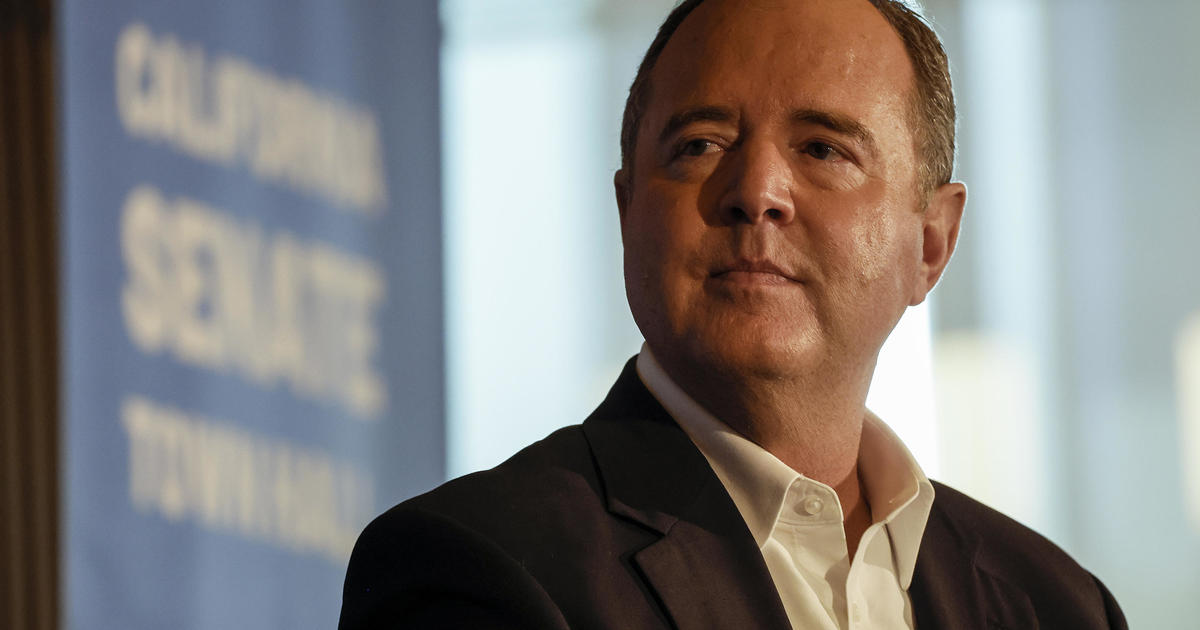CBS SF Talks To 'Murder In The Front Row' Doc Director Adam Dubin
SAN FRANCISCO (CBS SF) -- The San Francisco Bay Area has a rich musical history dating back to the 1940s when the region was an important hub for West Coast blues and jazz players. While psychedelic rock bands like the Grateful Dead and the Jefferson Airplane that emerged from the Haight during the Summer of Love may be the first modern musical movement to come to mind when talking about San Francisco, another far less documented scene that began just over a decade later has arguably exerted nearly as much influence on modern sounds.
Adding the speed and aggression of hardcore punk to the metal and hard rock styles being perfected by British bands like Motörhead, Iron Maiden, Judas Priest and UFO during the mid-to-late 1970s, a group of young musicians spurred an exponential leap forward for heavy music in the early '80s with the rise of thrash metal. Metallica is commonly thought of as the Bay Area's biggest proponent of the newly emerging sound, but many don't realize that the band got it's start in Los Angeles before moving north at the behest of new bassist Cliff Burton in 1982 to the welcoming embrace of what was already a well established and thriving underground movement anchored by early groups including Exodus and Blind Illusion.
Using the remarkable 2012 photo book Murder in the Front Row: Shots From the Bay Area Thrash Metal Epicenter that featured kinetic pictures taken by early devotees Brian Lew and Harald Oimoen as a jumping-off point, documentary director Adam Dubin has delved deep into the primordial soup of SF's thrash metal history for a new film. Murder in the Front Row: The San Francisco Bay Area Thrash Metal Story features extensive interviews with not just key players from Exodus, Slayer and Metallica, but testimonials from the rabid fans and scene figures who served as the initial disciples of a style of metal music that would one day have a global reach and influence.
A private screening of the documentary is being held on April 20th at the Kabuki Theater, which back in the '80s was one of the key San Francisco music venues of the early thrash era, long before getting converted to a movie theater. The film is being screened in conjunction with an appearance by all-star group Metal Allegiance at the Fillmore later Saturday evening. MitFR interview subjects including Testament members Chuck Billy and Alex Skolnick, Exodus mainstay Gary Holt, Vio-lence guitarist Phil Demmel and Megadeth bassist Dave Ellefson are set to perform onstage, playing some classic songs from the thrash-metal cannon. The band line-up is rounded out by powerhouse drummer Mike Portnoy, co-founder and bassist Mark Menghi, Mastodon bassist/singer Troy Sanders, Armored Saint/Anthrax singer John Bush, current Exodus singer Steve "Zetro" Souza and classic-era Exodus guitarist Rick Hunolt.
CBS SF recently spoke at length with director Dubin, discussing his early experiences making seminal music videos for the Beastie Boys before he relocated to Los Angeles to direct and shoot videos with bands from Rick Rubin's Def American roster and his long career working with Metallica as well as the process of making the new Murder in the Front Row documentary and plans for the film to have its world premiere in San Francisco at the SF Doc Fest in late May.
CBS SF: So are you working on the final details with the movie in New York? Or are you in LA or here in San Francisco?
Adam Dubin: We're in Brooklyn actually. I'm a New York-based filmmaker and very happy to be doing this very Bay Area story. But I'm a New Yorker through and through. The post-production has been in New York. I do have to say that a lot of the interviews -- over 80 percent -- were shot in the Bay Area, and particularly in Fantasy Studios. This, to me, points up the importance of doing this work from a history perspective, because we shot all this great stuff at Fantasy Studios, and since then, we come to find out that Fantasy was unfortunately closed. So many great records and recordings from this scene and from all of San Francisco history.
CBS SF: I wanted to discuss your early history a bit. I saw the Beastie Boys book tour last year that you came up in when they talked about making the "Fight for Your Right (To Party!)" and "No Sleep till Brooklyn" videos. Did you have any experience outside of NYU film classes when you co-directed those videos? Or was that your entry point?
Adam Dubin: I had definitely worked in film. I started studying at NYU in 1982, specifically as a film student. I wanted to make films. And it happened to coincide with the rise of MTV, which had started maybe the year before. Not everybody even had MTV at that point. That's one of the classic stories, that it wasn't even that widely available. I loved that mixing of film and music. It was perfect for me. So I was working on all kinds of student films during that time, even including something with Rick Rubin on one occasion.
I've always said I have no doubt that Rick Rubin would have directed those Beastie Boys videos, except he was eyeballs deep in directing Tougher Than Leather, the Run DMC movie. So he was unavailable at that time and MTV needed a video badly. I don't have to tell you how valuable heavy rotation on MTV was back at that time in the mid-80s.
So Rick Rubin turned to my co-director, Ric Menello. He was basically the guy who worked the front desk at our dorm, but he was a film savant. Menello wanted to direct, but he had never directed anything before and I had. So Menello turned to me -- we were friends from long before that -- and it kind of all came together. We went and wrote those videos with the Beastie Boys. It was just us. There weren't a lot of people around.
So "Fight for Your Right (To Party!)" was shot over Thanksgiving Day weekend in 1986. A few weeks later it was on air and was the top video. It was amazing. And then a couple of months later, we went to do "No Sleep till Brooklyn." We shot that at a club called the World, which was a very famous club in New York on Houston and Avenue C, definitely a bad section of town at that time. But you could see already that there were suddenly people coming in and sitting behind us and giving notes when we were doing the second video.
Because by then, the Beastie Boys were a hit and famous and suddenly the record company was taking a lot of notice. There were people from Columbia Records there and hangers-on. It's what happens when things start blowing up quickly. And some of that was what the Beastie Boys were ultimately rebelling against when they up and left and went to the West Coast and took their operation over there. They've been very vocal about that kind of stuff in their history.
So my association with them was really just for that brief time and then they left Def Jam for their own reasons and that was it. I didn't have any further association with them, but I did see that show they did for the book and I thought it was tremendous that Mike and Adam were going around showing everyone how it happened. I loved the show. They actually just did it here again at the Kings Theater in Brooklyn.
CBS SF: Yeah, I would love to see it again. I hope they make a DVD or do something with it. It was a really beautiful bit of music history to experience. They and Run DMC were my point of entry for hip hop, just like a lot of suburban kids. Even though I was also listening to thrash metal AND going to see the Grateful Dead growing up here in the Bay Area.
Adam Dubin: Which you could be! This may even answer something for you. As I said, I was born and raised a New Yorker, so as the scene in Murder in the Front Row was going on, I was not really aware of that. I knew who some of the groups were, but I didn't know it was all tied together. But in New York, I was part of the rising hip-hop scene that the Beastie Boys and Run DMC came out of. I was hanging out wherever Rick Rubin was going.
So the one thing I think I brought to it was the understanding of the scene; that these things happen when there's a group of people getting together and there's an energy building around a new type of music that is not yet recognized by the mainstream. It's really being held together and supported by a core group of fans. So at that time in New York, hip hop was that thing.
As was hardcore punk, which was what the Beastie Boys rose out of. I saw Adam Horowitz so far back that he wasn't even in the Beasties yet. It was so far back that he was a punk rocker playing in the Young and the Useless. I would go to the hardcore matinee shows and he was there with that whole gang of kids like Dave Skilken. You wouldn't have thought, "Oh, those guys are going to be famous." They were just some of the kids who were part of the scene and you knew who they were. It was pretty cool. A different place and a different time.
CBS SF: I was curious about what you did between making those videos with the Beastie Boys and connecting with Metallica. Looking at your website that features some of your other early work, I saw videos you made for Def American artists like the Black Crowes and the Four Horsemen, who I think were one of the real unsung bands from LA in the late '80s and early '90s. Did you sort of end up being the house video director for the label there in LA?
Adam Dubin: That's pretty much it. After the Beastie Boys split, Rubin left. He didn't really say goodbye. Nobody knew that he was going to stay in LA, but work started taking him there. But I think basically you could sort of see Def Jam splitting up even while they were there. Rubin wanted to do something like Slayer and he had other ideas. I knew he was going to do something with Danzig long before that first album because I went and shot some stuff of Danzig.
Basically Rick and Russell did what they did for that certain period of time and clearly, as the success started to happen, their musical tastes varied and they both wanted to go in their own direction. The fact that both of them were successful in their own direction just shows how they were capable of doing something.
So Rubin's direction at that point...he'd done what I think he'd wanted to do with hip hop. To me, the last amazing thing was that Public Enemy record It Takes a Nation of Millions to Hold Us Back, and LL Cool J doing "Goin' Back to Cali." Those were just amazing pieces of work to sign off with. And then Rubin went to the West Coast and I followed him essentially.
I wouldn't say I was the house video director, but I wound up working with a lot of acts on Def American. I did the music videos for the Four Horsemen -- those guys became friends at the time -- and I did a band called Wolfsbane. I did two videos for a band called Trouble. So I was doing a lot of hard rock and heavy metal stuff and I was doing a lot of shoots for Danzig, although I never directed one of his videos. We would shoot a lot of his live shows. And all of that stood me in good stead for working with Metallica.
When my name got dropped in the hat to possibly shoot a documentary of what they were doing, the fact that I'd worked with Danzig and Rick Rubin putting in a good word for me, that was all good for my credibility with Metallica. But ultimately I had to go in there and pitch my idea of how to do the documentary and not interfere with what they were going in to do, which was to go in and record the next album after And Justice For All...
Nobody really knew what that was yet, but it promised to be something really cool. And then it ended up being better than cool; it turned out to be the biggest album they ever had, which was the Black Album. So I was in there doing a lot directing and a lot of shooting. And all of that led to an audition with Metallica. And thankfully they said, "Yeah, we can tolerate this guy being around us every day with his camera." And I just kind of melted into the woodwork and they took to me and it all worked out.
I'm still working for them 29 years later. It was October of 1990 when I walked into their studio, so literally coming up on 30 years. I'm just now reediting a bunch of stuff that will be part of the Black Album reissue package, so it's kind of nice being back with them and doing it again. And it's certainly nice to have this cherished relationship that we've had. It's wonderful.
CBS SF: To get to the documentary, you've already touched on what led you to use the Murder in the Front Row photo book as a framework for the film. He had mentioned that you had met – I think – at the Metallica Rock and Roll Hall of Fame induction a couple of years before the book came out?
Adam Dubin: Yeah, he's right. We met in person at the Hall of Fame induction for Metallica. They had a party and I knew he was part of this core group of fans, you know? Almost fan #1 really, but I didn't know the whole backstory. And then a few years later we ran into each other and he gave me the book. The simple answer is I just fell in love with the book. I was a great story. I still feel blessed that no one has done this story. It was almost like coming upon the story of CBGBs or something and nobody having touched it.
This for me was even better. I came into Metallica's world in 1990. I always want to go back and see where they came from. They didn't just arrive. They built themselves. And the way Metallica and the other bands in the Bay Area scene were able to build themselves was because of this wonderful group of fans who got what they were doing and would go to the shows and make the flyers.
If they weren't the musicians, they were doing all these things to support the musicians and the scene. Any early band needs that kind of support, but in the Bay Area, it was really cool because the musicians would support each other. And that's why there was this kind of movement.
It was a wonderful scene. It's been a fantastic experience working on this film. Brian and I have become friends. We first met through our associations with Metallica, but once he showed me that book, I was literally grabbed by it. It sat on my nightstand table right next to my bed for several years. I would just thumb through it. I knew I had to make this documentary. Those photos have so much energy, they're so alive, you can feel the sweat from them. I just had to do it. So eventually, I got everything together and approached Brian and he said, "Yeah! Let's go do this!"
And to me, what speaks volumes is that Metallica shows up in the Bay Area in the fall of 1982 and by early '83, fully 50 percent of the band is Bay Area musicians with Cliff and Kirk joining the band. And they lived there as well, though as Brian likes to point out, they never were home much because of all the touring. But they were definitely a Bay Area band. But I don't want to dwell on Metallica, because the other history is so rich. That's the part I didn't know and that's what really attracted me.
I mean, I kind of knew about Exodus and that Kirk had formed the band, but I didn't know much about them. And what I came to find out was this wonderful other band that kind of became the house band of the town. Exodus was the go to band if you wanted metal, because Metallica was away. Exodus was playing shows and building the world of thrash and inspiring other musicians. So what you have is people would see Exodus and pick up a guitar themselves and start to play in all these amazing bands that started developing in the Bay Area.
We only touched on some of them because there's only so much you can do in a movie, but we certainly talked about Testament and Possessed and Death Angel to name a few of them. But there are many more. And I love what Gary Holt says in the movie: "If your own area wasn't welcoming to you, we would be." And what he meant by that was, bands like Slayer and when Dave Mustaine got Megadeth going, he brought them right to the Bay Area. These bands knew where to take thrash music. In the Bay Area, the young people there, got what they were doing. And you could have great shows. And they did!
CBS SF: Yeah, it was a ready-made audience for those bands. To what extent did the connections you'd made working with Metallica pave the way to the musicians you ended up talking to and how much of that was through Brian and Harald? I imagine you would have met a number of the members of the Big 4 over time, but did they provide you with a list of some of people from the early scene to talk to?
Adam Dubin: I have to say that Brian Lew was like my co-pilot on story issues the entire time. There was an initial meeting with Brian and Harald once I optioned the book and they threw all their ideas together. My job as a filmmaker was to craft what would be the story. It could almost go in a hundred directions, so I had to pick one and make it go. And through that, I started to get acquainted with a number of the early core fans who are interviewed in the movie.
One thing I could bring to the movie was this relationship that I had with Metallica, but we were all very clear that there was no point even interviewing Metallica until we'd interviewed a whole bunch of fans. I must have been 30 interviews into the process before I even approached Metallica. By that point, I'd interviewed a lot of people who had been in the early scene, many of them folks who Metallica had known coming up. Only then would I request that the band sit for me, and one of the things I'll always be grateful for is that all four of them very generously gave me their time.
Slayer sat for us, which was tremendous. Separately I got Dave Lombardo, which was tremendous. It was great because we were going back to talk about such an early time that, whatever personal things may have happened later on in the long lives of these people, this was all before that. They were all kids. So the interviews weren't about whatever Dave Lombardo thinks about Slayer now or what they think about him. It was all back before that, when they were just one band trying to get ahead with what they were doing.
I'll tell you this. There was a kind of magical thing that I would do when I did these interviews. I would print pictures from the book. I scanned pages from the book and printed the pictures on like a hardback card. So I'd bring maybe five or so pictures to each interview. What I found was it was amazing to see what happened to people.
This worked just as well on rock stars as non rock stars. I'd kind of do my main interview and then ask, "Can I show you some pictures?" And everybody was, "Yeah, sure." And I'd show them the pictures from the book and you would watch somebody who was basically 50 years old melt away. Suddenly they were staring at their younger selves or the scene. Maybe it wasn't a picture of them, but it was a bunch of the old gang, and you would watch them transform before your eyes into the young person they had been.
It was emotional for them. It's emotional for me, just thinking about it. It transformed them and put them back in that moment. And on some occasions, people would not turn the picture around, but some people would hold the picture up and show it to me and describe things in it. In every case, it worked like a charm. It was a wonderful device. And it just goes right back to those fabulous pictures of Brian Lew and Harald Oimoen.
CBS SF: That's a great interview idea. I was going to ask how you prepared to do the interviews and how different they were from person to person. I mean, a musician, you know their history or you can research it pretty easily, where as a lot of the people in the scene, you're having to dig a little deeper and they're probably not as used to doing interviews. So that makes perfect sense that you'd use the photos to evoke a response...
Adam Dubin: In every case, I prepped for every interview. I feel what I bring to it is the kind of research that a book author would be doing in a deep dive for a subject. It's up to me to be prepared. Of course, I would lay out some ideas that I wanted them to touch on, but I also know when to back off. If somebody is developing an idea, don't interrupt them. Let them go. Sometimes you get some wonderful stories. Basically, what you're doing is jogging these people's memories of that time.
And there was something interesting about it. I realized during the process that everybody was ready to speak about this now. I think if I'd approached this material ten years ago, I don't think everybody was ready yet. But everybody right now is at this time when they realize that it was really important. That they were involved in something that was culturally important. That it was a movement.
And I think we all realize that sort of thing as time goes by and you get a little older. Maybe not everybody's here with us who was there then, and you start to realize that, wow that was really a cool time. You might not have felt great the whole time, but you realize you had these people around you that made you feel good. And that's what I got, I think, from everybody. Everybody expressed that.
And of course, in some cases, we had to have people speak for other people who couldn't be there. Very poignantly, Durelle Ali speaks for her father, Wes Robinson, who ran Ruthie's Inn. Wes Robinson is beloved by all the people who I spoke to, but it was wonderful to have her come and speak on his behalf and kind of remember the importance of what he did in providing this club for people to be able to play and gather together.
CBS SF: Had you stayed in contact with Kerry King since first working with him on the "No Sleep Till Brooklyn" video? Or was the interview for the film a reunion?
Adam Dubin: I had not. I did not have a connection with Slayer during all these years. I came in kind of cold and only at the end of the interview did I remind him that we'd once shared a stage. Kerry King and me in a gorilla suit! So he's forgiven for not recognizing me. It's been a lot of years. But he was very cool and he was generous with his time. It's great to have the great Kerry King sit before your camera. He is a charismatic presence, the same thing that he is onstage. He's amazing.
CBS SF: The movie focuses on some of the major events in Bay Area thrash history like several landmark shows by Metallica, Slayer and Megadeth, Day on the Dirt and Metallica appearing at Day on the Green with the Scorpions. One thing that wasn't covered was the Thrash of the Titans benefit for Testament singer Chuck Billy and Chuck Schuldiner of Death that led to several local thrash bands reuniting, including Testament, Exodus and Death Angel. Was it just a matter of wanting to keep the movie focused that led to leaving out later developments?
Adam Dubin: I think you just said it, but I'll say it this way: The movie at any given time could go in 50 directions, and my job as a storyteller is to keep it on a path. I keep thinking about showing it, not to people like yourself who know the story, but really to people who don't. The movie should stand as a testament to what happened here. So I'm trying to keep that together. I knew about the benefit for Chuck Billy and I think it would have been a good angle.
At some point, I think it was in 2017, I went to a Metal Allegiance show. I think it was a NAMM show in LA. And what I saw in front of me was very special. At that show, I saw a gathering of musicians and a good chunk of them were Bay Area musicians, but a lot of them were from other places and bands. And they were playing a lot of music and a lot of it was Bay Area thrash. And it seemed to me that what Metal Allegiance was doing was like a living, breathing modern day representation of what the Bay Area thrash scene was. At least half of the musicians were Bay Area folks and they were doing a lot of the catalog.
And during that time, Ray Burton Cliff's dad got up and was honored there by Marc Menghi, one of the Metal Allegiance guys. And I just thought, "Wow, this is a great example of these guys wanting to be together and have fun playing together." It was happening right in front of my eyes.
So the following year, when the did the same thing for NAMM in 2018, we filmed the concert. And there in front of my camera, I've got all these Bay Area guys. Chuck Billy and Gary Holt and Alex Skolnick and Mark Osegueda from Death Angel. And they're all just kind of swapping stories like guys who've known each other for all the years that they have. And you add in all these other great rockers and you have kind of this mixing and melding of all kinds of styles and musicians having fun playing together. That was a pretty cool way, in my mind, to kind of take it into the now.
CBS SF: So a lot of the film moves in a fairly linear way as far as the time line, but as the film progresses, there is a little jumping back and forth. Beyond the brotherhood that's a central theme and how you are able to see what a strong connection the fans had as a community, it's pretty clear that Paul Baloff and Cliff Burton emerge as these central characters who were the heart and soul of the scene. Without those two members of those two bands, it seems like a lot of what happened wouldn't have happened.
I guess that's something I've always kind of felt as a longtime fan and someone who followed both Metallica and Exodus. It must have been difficult to figure out where you were going to put in Baloff's story and how it ended. I thought the scene of Gary and Tom visiting his grave was one of the truly touching moments of the film. Was determining where that was going to end up in the movie in relation to Cliff's passing one of the bigger challenges of editing the film?
Adam Dubin: Yeah, it was a challenge to figure out where stuff fits in. Believe it or not, that scene at Baloff's grave with Gary and Tom moved a bit during all of this. Cliff's death was always where it is. We tell the story and it comes up to this sad thing that we all know took place. But Baloff kind of moved around, because we didn't want to have the two scenes about their passing stacked up on each other.
So that moved around a little bit until we found a place where it was proper and respectful to this guy who was definitely a larger than life character and was so beloved by all these people in the scene. I made a decision while making the movie that I didn't want to go into drinking and drugs and stuff. I don't mind mentioning some drinking, but this wasn't going to be a Behind the Music type documentary.
I just wasn't interested in going there, because there was too much good stuff to talk about to waste any time with that stuff. So we didn't really focus on it. For some people, it may come up a little suddenly that Baloff is not with us any more, and if they want to find out the reasons why, that's their own business. But I think I wanted to put it in the right place where it was respectful to his memory and still make sense
I had one day, really just a few hours of a day, where Gary and Tom were generous enough to give me some time. And we just decided to go back to their old haunts. But I have to tell you, it was not my idea to go to Baloff's grave. They suggested it and I was like, "Yep. Let's do it." But we just had time to visit three places. It was Baloff's grave, Alvarado Park -- where Exodus had played as 16-year-old kids --and of course, revisiting the closed doors of Ruthie's Inn. And that seemed to elicit the kind of interesting and thoughtful stories and funny stories that they told, some of which were on camera.
CBS SF: Well, you again covered a couple of additional topics I was going to ask about. As someone who was there for part of the scene, the absence of drugs -- speed in particular -- in the movie was striking. I don't know if you'd say it was intrinsic to the tempos of the music that was being played, but I think it had something to do with it. But I also understand the approach you took as a creative choice that you're making about the film.
Adam Dubin: Yeah, I can agree with you. If you were there, you know there were a lot of things going on. But, ultimately, you make a choice. And this is something I'll say about Metallica also; I've been interviewed about Metallica a million times, and some people have tried to go into the band being called "Alcoholica" and what about the drugs. And what I'd say about them and about the whole scene: Don't ever get too distracted by the salacious stuff -- the sex, drugs and rock and roll part of it -- because really what came first was the music. And that's what I found; a dedication to music in all of these guys.
With the guys in Metallica, the music came first and I noticed it again with these musicians who I didn't know personally but was meeting and learning about. And Gary Holt was honestly very open about some of his drug use, but I just chose not to put that in the movie because there was nothing really to talk about it was that interesting, in the end. What was more interesting was what he said about the music, so I chose to follow that. So I never get too waylaid by that. That all starts to reek of Behind the Music type stuff that I want to stay away from. It just didn't interest me.
CBS SF: The animation that you used in the film is really great. Some of it is used to recreate moments that are pretty well known to fans, some just illustrates what was going on with humor and style. Were these animators you had worked with in the past through what you've done with Metallica?
Adam Dubin: Let me tell you about them. There's this wonderful animation studio in Brooklyn called Augenblick Studios and this guy Aaron Augenblick runs it. He's got a chief animator named Mike Wartella who did all that key animation and they just got it. We knew each other and I knew Augenblick Studios, but I did not do a job with them before this. But I knew they were there and we had a meeting. And during the meeting, they just got it.
I don't know how else to say it. They loved the music, but more than that, they got the feel of it. There's something about that style of animation, that R. Crumb style of craziness fit with what we were doing. So initially we started out with like six animations. But it was when they did the one big one about Rich Burch, the sketch where he's the guy with the boombox.
Several people described to me about how he was like a pied piper or a Johnny Appleseed. He was walking around with his giant boombox blasting Motörhead. Lars remembers him, Erik Lannon remembers him, Harald Oiman remembers him. Everybody had a memory of him. And I said, "Well, we've gotta do something with this guy." He's not alive any longer, unfortunately.
And Augenblick Studios drew this great animation of this guy wearing a denim jacket with a Thin Lizzy back patch, blasting Motörhead so loud that his hair was blowing from the sound of it. When I saw that animation, I thought there was a dozen other places where we could use animation. So they got it and just ran with it. They do a lot of stuff for Adult Swim and animation for things like that. They do great work there and I just knew that they would be a great partner for us.
CBS SF: I guess the last bit of business I wanted to talk about was your plans for the movie. I know there's a private screening coming up on April 20th at the Kabuki in San Francisco's Japantown in the afternoon before the Metal Allegiance show happening that night. I'm guessing it's a private screening, because the San Francisco International Film Festival is also happening, but I didn't see anything connecting the two. If that's not a public screening, when are you going to first show it here and what else do you have planned as far as film festivals and a theatrical release?
Adam Dubin: So we're having a private screening at the Kabuki followed by the Metal Allegiance show. That's something that's going to be for a lot of family and friends for the film. I know we've done some contests and stuff that are getting people in, but it's basically a private thing. However, while we are not part of the San Francisco International Film Festival, we are going to be in the San Francisco Doc Fest.
Tickets for Doc Fest will go on sale May 1st on their website when that opens for business. Our screening of Murder in the Front Row that will be the first public screening for the film is on May 31st at 9 p.m. at the historic Roxie Theater in the Mission District. We're really excited about that. We figure as soon as the tickets go on sale, we'll sell out the theater at least one time and they'll probably announce some more screenings after that.
CBS SF: I would bet you guys might be able to fill the Castro Theatre with the fan base that's here.
Adam Dubin: That would be really cool. We decided for this first screening we wanted to something cool and historic. And the Kabuki which has seen and hosted so many of the metal shows from that day before it became a movie theater seemed like the perfect place. And it was right down the street from the Fillmore, which is also historic and cool. To that worked for us geographically. But we're really proud to be in the San Francisco Doc Fest. That's going to be a great show. I'm going to come back to town for that one and do some Q&A after the screening. I'm proud that the movie is doing it's world premiere in San Francisco. It's exactly where it should be.
CBS SF: Do you have any other festivals planned currently that you can talk about?
Adam Dubin: There are some that are way out, kind of out into the fall. I don't have anything that I'm promoting yet. There's one in Mexico and one in Athens and somebody just reached out to us from Barcelona. What's very interesting is that it's coming from all over the world. As people have found out about this film, the outreach has become international. I think that speaks about the music more than anything else. People love the music and they want to learn about it. And that's what our film can help do.
More Information: Murder in the Front Row website

